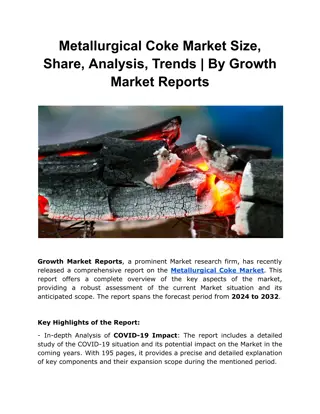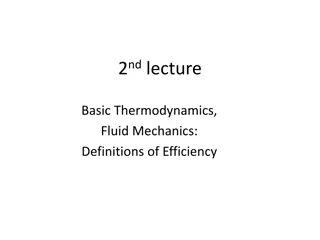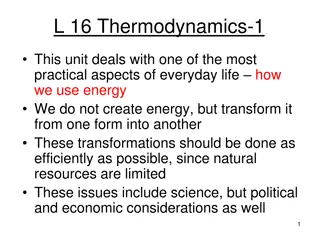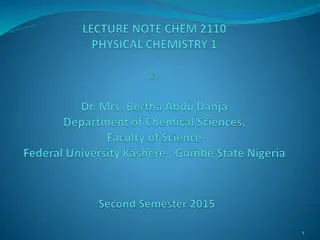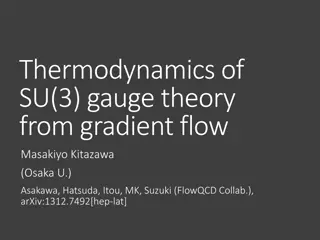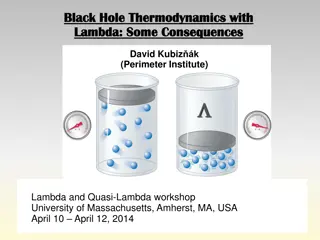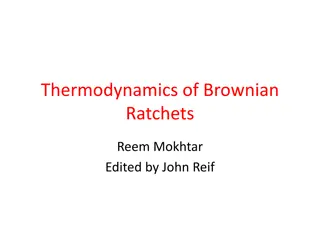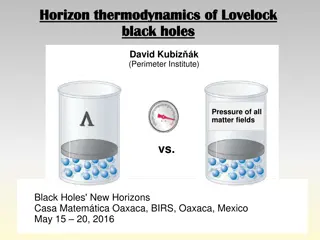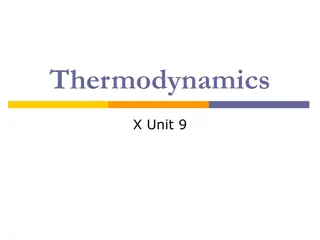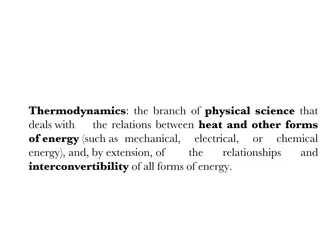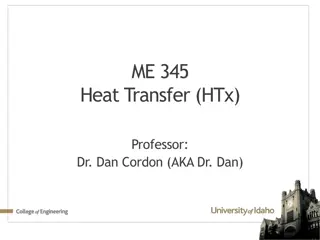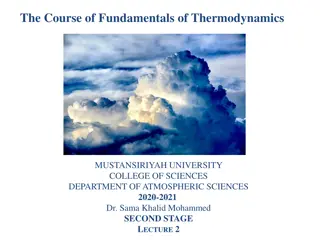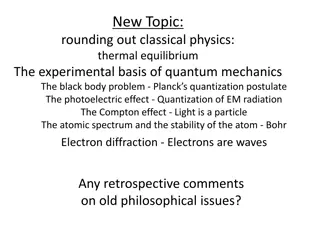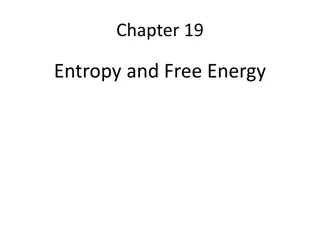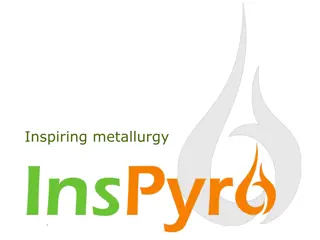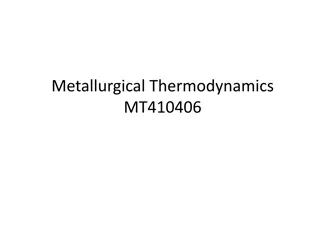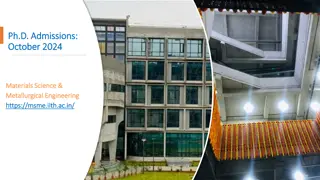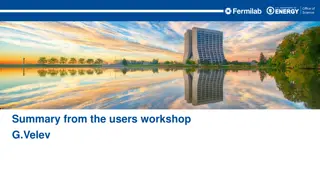
Understanding Thermodynamics: Laws, Internal Energy, and Heat Processes
Explore the laws of thermodynamics, including the first law emphasizing energy conservation, internal energy concepts, specific heat, and various heat processes. Delve into the significance of these laws in understanding energy interactions within systems.
Download Presentation

Please find below an Image/Link to download the presentation.
The content on the website is provided AS IS for your information and personal use only. It may not be sold, licensed, or shared on other websites without obtaining consent from the author. If you encounter any issues during the download, it is possible that the publisher has removed the file from their server.
You are allowed to download the files provided on this website for personal or commercial use, subject to the condition that they are used lawfully. All files are the property of their respective owners.
The content on the website is provided AS IS for your information and personal use only. It may not be sold, licensed, or shared on other websites without obtaining consent from the author.
E N D
Presentation Transcript
Unit II First law of thermodynamics, Internal energy, Heat capacity, Specific heat and latent heat, Enthalpy, Isothermal and adiabatic processes, State properties, Heat of reaction, Heat of formation, Standard heats, Heat of transition, Hess s law, Kirchhoff s law equation. Second law of thermodynamics, Entropy of irreversible processes, Auxiliary functions, combined statements of 1st and 2nd laws, Maxwell s relations, Gibb s-Helmholtz relations. Third law of thermodynamics, Clausius Clapeyron equation, Temperature dependence of entropy, Statistical interpretation of entropy, Consequences of third law, Nernst heat theorem, Equilibrium constant, Van-Hoff equation, Concept of fugacity, activity and mole fraction
1st Law of Thermodynamics (TD) Conservation of Energy Effect of Heat on a System q = Ef Ei = E Effect of Work on a system Ef Ei = E = W _ Total Energy entering the System ( EIN ) Total Energy leaving the System ( EOUT) Change in Total Energy of the System ( E ) = First Law of Thermodynamics (TD): E = q-W W = work done by the system upon the surrounding For infinitely small change in internal energy of the system, First law of TD: dE = q W = q PdV W = q PdV (Assuming W = 0) PdV = Work done against an external pressure; W = all other form of work done (i.e. electrical, magnetic, gravitational etc.)
Significance of 1st Law of TD It is based on law of conservation of energy It introduces the concept of internal energy It separates heat interaction (Thermal) and work interaction (Mechanical) It treats internal energy as state property (i.e. independent of path for the change of state)
Quiz The internal energy of a system increases during some time interval. Which one of the following statements concerning this situation must be true? a) The increase in internal energy indicates that work was done on the system. b) The increase in internal energy indicates that heat was added to the system. c) The increase in internal energy indicates that work was done by the system. d) The increase in internal energy indicates that heat was removed from the system. e) The information given is insufficient to indicate the reason for the increase.
Quiz (Contd.) A gas is enclosed in a cylinder by a piston. The volume of the gas is then reduced to one half its original value by applying a force to the piston. Which one of the following statements concerning the internal energy of the gas is true? a) The internal energy of the gas will decrease. b) The internal energy of the gas will increase. c) The internal energy of the gas will neither increase nor decrease. d) The internal energy of the gas will equal the work done in moving the piston. e) The internal energy of the gas may increase, decrease, or remain the same depending on the amount of heat that is gained or lost by the gas.
Quiz (Contd.) Which one of the following statements is not consistent with the first law of thermodynamics? a) The internal energy of a finite system must be finite. b) An engine may be constructed such that the work done by the machine exceeds the energy input to the engine. c) An isolated system that is thermally insulated cannot do work on its surroundings nor can work be done on the system. d) The internal energy of a system decreases when it does work on its surroundings and there is no flow of heat. e) An engine may be constructed that gains energy while heat is transferred to it and work is done on it.
Basic Terms Heat Capacity: The amount of heat required to raise its temperature by 1oC. C = q/dT (Joule/Kelvin or Joule /oC) Different materials require different amount of Energy for their temperatures to increase thought unit quantity ( i.e. 1 C) for identical mass. Hence, it is required to define a Property 1 kg Fe 1 kg H2O to compare the ENERGY STORAGE 20 30 C 20 30 C CAPACITY of different substances. 41.8 kJ 4.5 kJ This Property is known as SPECIFIC HEAT.
Basic Terms (Contd.) Definition of Specific heat : m = 1 kg T = 1 C The Energy required to raise the Sp. Heat = 5 kJ/kg C temperature of a unit mass of a substance 5 kJ by 1 degree. Atomic heat capacity is the heat capacity of 1 atom of an element Molar heat capacity is the heat capacity of 1 mole of a substance.
Basic Terms (Contd.) q is incomplete differential because it is not a state variable (i.e. it depends on the path followed) Heat Capacity at constant pressure ( q/dT)P : It is easy to determine heat capacity at constant pressure via experiment Heat Capacity at constant volume ( q/dT)V : Theoretically, it is easy to determine heat capacity at constant volume
Heat Capacity at Constant Volume dE= q-PdV (from 1st law of TD) ------1 Since, E = f(V,T) , ----2 Combining Eq. 1 and 2, E PdV q T E PdV q T E E = + dE dV dT V T T V E = + dV dT V T E V Or: = + + dV dT V T V E = q dT At Constant Volume, dV = 0; T V q E = = C Hence at Constant volume, , V dT dT V V
Heat Capacity at Constant Pressure dE= q-PdV (from 1st law of TD) ------1 Since, E = f(P,T) , ----2 Combining Eq. 1 and 2, E PdV q T E PdV q T E E = + dE dP dT P T T P E = + dP dT P T E P Or: = + + dP dT P T P E = + q PdV dT At Constant Pressure, dP = 0; Hence at Constant Pressure, V P T T P + ( ) ( ) q E PV E PV E = = + = + = C P T T T T T P P P P P P
Relation Between CP and CV V E E = + = C P C P V T T dT P P V V E E = + C C P Therefore, P V T T T P P V E E = + dE dV dT Since, E=f(V,T) V T T V E E E E = + Now dividing both sides by dT at constant pressure: T V T T P T P V V E V E E E V Therefore, = + + = + C C P P P V T V T T T V T P T P V V T P
CP-CV for Ideal Gas E V = + C C P P V V T T P V R RT = = V For ideal gas: Therefore at constant pressure, T P P P For Ideal gas, energy is a function only of temperature and it does not change with volume at constant temperature, i.e. 0 = T V E Therefore for an ideal gas at constant temperature: CP CV = R
Effect of Temperature on Heat Capacity = + + 2 CP a bT cT Where a,b,c are constants for a particular range of temperature Salient Features: 1) The term CT-2 is omitted because it is often too small 2) This equation is used for solid metals and compounds at elevated temperature 3) For liquid metals with insufficient data, Cp is assumed to be constant. ? CP (J/K) T(K)
Importance of CP and CV Which is more important to Metallurgist CP or CV ? E T V E = + = C P C P V T dT P P V E E CP > CV Considering: T T V P He Gas CP is always greater than CV; as the System is allowed to expand in case of Const. Pr. and V = Const m = 1 kg T = 1 C P = Const m = 1 kg T = 1 C the Energy for this expansion Work is also need to be supplied. 3.12 kJ 5.19 kJ CV = 3.12 kJ/kg. C CP = 5.19 kJ/kg. C
Specific Heat Capacities To relate heat and temperature change in solids and liquids, following equation is used: T mc Q = specific heat capacity The amount of a gas is conveniently expressed in moles, so following analogous equation is used: = Q nC T molar specific heat capacity
Specific Heat Capacities Constant P For gases it is necessary to distinguish between the molar specific heat capacities which apply to the conditions of constant pressure and constant volume: P C , VC = U nR T 3 2 ( ) ( ) =2 nR T 5 =2 + nR T T nR T T = + 3 Q U W f i f i constant pressure = W P 5 V first law of thermodynamics nR T Q =2 = CP n T n T constant pressure for a monatomic ideal gas = CP R 5 2
Specific Heat Capacities Constant V = U nR T 3 2 ( ) 0 + =2 nR = + = T Q U W 3 nR T T 3 constant pressure f i 2 first law of thermodynamics constant volume for a monatomic ideal gas = CV R 3 is the ratio of the molar specific heat capacities at constant pressure and volume 2 R 5 C 5 = = = monatomic ideal gas 2 P 3 C R 3 V 2 = C C R any ideal gas P V
Basic Terms (Contd.) Enthalpy (H): Greek word meaning worm It is the total heat content of a system PV E H + = E- Internal Energy, P Pressure, V - Volume H is a state variable since E,P, and V are state variables. For a cyclic process, H = 0 = + ( ) E PV H = C P T T P P First Law of TD (in terms of Enthalpy): dE = q W = + H E PV By Definition: = + + dH = dE PdV + VdP + By differentiating: q PdV PdV VdP = + q VdP H = q = dH q Therefore, at constant pressure (dP = 0): At constant pressure, change in enthalpy of the system is equal to the heat absorbed by the system from surrounding or heat exchange between the system and the surrounding
Enthalpy (KJ/mole) Example 1: C(s) + O2(g) CO2(g) + heat evolved ( H = -393 KJ/mol) H = Hfinal - HInitial Since, H < 0, Therefore, Hfinal < Hinitial Exothermic reaction (i.e. Reaction that results in release of heat energy) Example 2: ZnO + C Zn + CO heat absorbed ( H = +350 KJ/mol) Since, H > 0, Therefore, Hfinal > Hinitial Endothermic reaction (i.e. Reaction that results in absorption of heat energy) Case I: Enthalpy of pure element is generally taken to be zero at reference temperature (298K) and 1 atm pressure provided it is in normal state. Example: H0298[C,graphite] = H0298[O2(g)] = H0298[Fe(s)] = H0298[Hg(l)] = 0 H0630[Hg(g)] = 60.84KJ/mol Case II: Enthalpy of a compound is taken to be its enthalpy change of formation. Example: C(s) + O2(g) CO2(g) DH0298 = -393 KJ/mol H0298[CO2(g)] = H0298[CO2(g)] = -393 KJ/mol
Enthalpy Change (KJ/mole) H depends on: 1) Temperature, 2) Pressure, 3) Physical state of reactants and products, and 4) Amount of substances reacting H C = ( ) dH C dT = Since, Therefore, P P T P On integrating H T T Case I: Enthalpy change when substance is heated from T1 to T2 at constant pressure 2 2 T 1 T = dH C PdT H 1 Case II: Enthalpy change when substance is heated from T1 to T2 at constant pressure with phase transformation from solid to liquid phase at Tf H T Where: CP(s) = Heat capacity of solid CP(l)=Heat capacity of liquid Lf = Latent heat of fusion Tf = Temperature of fusion T T f 2 2 T 1 T T = + + dH C dT L C dT ( ) ( ) P s f P l H f 1
Enthalpy Change (KJ/mole) Due to Chemical Reactions 1. Heat of Reaction ( Hr): Heat generated or absorbed due to chemical reaction 3Fe2O3(s) + CO(g) 2Fe3O4(s) + CO2(g); Hr = -2.67 KJ/mole [( tan Re Pr ts ac oducts r H H H = = + + 2 ) 3 )] H H H H Fe O CO Fe O CO 3 4 2 2 3 2. Heat of Formation of Compound ( Hf): Enthalpy change when 1 mole of compound is formed from its constituent s elements 2Al(s) + 3/2O2(g) Al2O3(s) ; Hf,Al2O3 = -1700 KJ/mole [( tan Re Pr ts ac oducts f H H H = = 0 0 / 3 + = ( 2 )] H H H H Al O Al O Al O 3 3 2 3 3 3. Heat of Combustion of a substance ( Hc): Enthalpy changed when 1 mole of substance is completely burnt (Same as heat of formation for the compound) C(s) +O2(g) CO2(g); Hc,298 = -393 KJ/mole Mg(s) + 1/2O2(g) MgO(s); Hc,298 = -605 KJ/mole 4. Heat of Transformation or Latent Heat: Enthalpy change when 1 mole of the substance undergoes a specific physical change (melting, evaporation etc.). Latent heat of fusion is the heat supply for transforming solid to liquid at fusion temperature. Zn(s) Zn(l) at 693K, Lf,Zn = 7.28 KJ/mole 5. Heat of Solution: Enthalpy change when 1 mole of solute is dissolved in solvent. It depends on the concentration. Heat of solution increases with the decrease in concentration
Hess Law Hess Law states that for an isothermal process, the enthalpy change for a reaction is the same whether it takes place in one or multiples stages. i.e. Heat of reaction depends on the initial and final states of the process A B = + + H H H H AB AC CD DA C D Example: Direct oxidation or the single stage process: i) CH4 + 2O2 CO2 + 2H2O; Hr,1 = -890 kJ/mole Indirect oxidation or three stages process: i) CH4 C + 2H2; Hr,2 = 77kJ/mole ii) C + O2 CO2; iii) 2H2 + O2 2H2O; Hr,4 = 2(-287)kJ/mole CH4 + O2 CO2 + 2H2O Hr,1 = Hr,2 + Hr,3 + 2 Hr,4 = 77+(-393) + (-574) = -890 kJ/mole Hr,3 = -393kJ/mole
Salient Feature of Hesss Law 1. The principle of algebraic addition, subtraction etc. of chemical equations is applicable to the energy changes or enthalpy changes 2. Chemical equations can be multiplied by suitable coefficients and then added or subtracted to get desired equation. The value of state variable ( E, H etc.) should be manipulated accordingly 3. Hess Law is applicable to isothermal process, i.e. constant temperature 4. This law is of great help in TD calculation for the reactions that are difficult for experimental study. Process 1 Process 2 State 2 State 1 T T State 2 State 1 Process Process Hess Law is applicable to which process?
Reactions at Different Temperatures - Kirchhoffs Law Kirchhoff s Law states that if a system undergoes a change from one state to another state then both internal energy & heat occur would alter dT ( ) H ( ) d H = = C CP Since, Therefore, P T P T 2 H ) = = ( d H C dT + = 2 T ( ) d H C dT On integrating P P H 1 T T + 2 CP a bT cT 1 = ( ) C C C , Pr , Re tan P P oduct R ac t T 2 = + ( ) H H C C dT Therefore, 2 1 , Pr , Re tan T T P oduct R ac t T 1 Kirchhoff s Equation According to Kirchhoff s Law, heat of reaction is a function of temperature
2nd Law of Thermodynamics Clausius Statement: it is impossible for a self acting machine working in a cyclic process without any external force, to transfer heat from a body at a lower temperature to a body at a higher temperature. It considers transformation of heat between two heat reservoirs. Kelvin Plank Statement: it is impossible to construct an engine, which is operating in a cycle produces no other effect except to external heat from a single reservoir and do equivalent amount of work. Alternate Statements: 1) Heat absorbed at any one temperature can not completely transformed into work without leaving some change in the system or its surrounding. Examples: In electrical machines The efficiency of the conversion of electrical to mechanical energy and vice-versa can be 90% max. In heat engine The efficiency of the conversion of heat energy to work is in the range of 10%-40%. 2) Spontaneous processes are not thermodynamically reversible. Entropy distinguishes between reversible (i.e. equilibrium) and irreversible (i.e. non- equilibrium or spontaneous) process. 3) For a spontaneous (i.e. non-equilibrium) irreversible process, the entropy of an isolated system always increases.
Basic Definition: Entropy In a reversible process, when a substance absorbs infinitesimal amount of heat ( q), in a reversible manner, at an absolute temperature (T), the entropy of the substance increases by dS: T T=Temperature of the substance (K) q dS = change in entropy (J/K/Mole) qrev = heat absorbed by a system in a reversible process = rev dS Based on statistical concept, entropy may be defined as a measure of randomness or a disorder in the system Boltzmann Entropy Equation: ! N ( ) ) n = = = ln ln ln( ) ln( ) ( ) ln( S k W k k N N n n N n N ( ! n )! N n ( ) = ln( ) ! ln( ) N N N N Using Stirling s Approximation: Entropy is a thermodynamic property depending only on the state of the system Differential form: Integral form: It is for isothermal and reversible process It is a measure of disorder of the system, higher the disorder, larger is the entropy It is a measure of heat available for work q q = rev dS = = rev S S S T B A T
Entropy Change + = 0 S S For reversible process: System Surroundin g + 0 S S For irreversible process: System Surroundin g 2nd Law of TD: An irreversible process in an isolated system will occur with an increase in entropy q q C = = C q C dT = = rev P dS dT Therefore, Since, P rev P T T T P 1) Entropy change for a substance when it is heated from T1 to T2 T C m = = dT P dS S S T T T 2 1 T 1
Entropy Change (Contd.) 2) Entropy change with a change of state (Solid Liquid) T T C L C m 2 dT dT ( ) ( ) P s f P l = = + + dS S S T T T T T 2 1 m T T 1 m S = 10.5J/K/mole S = 98.3J/K/mole Example: Zn(s) Zn (l) Zn(g) 3) Entropy change for a chemical reaction: When reversible reaction takes place: 1) At constant temperature: q = rev S T q H = = rev S 2) At constant temperature and constant pressure: T T Entropy change for a chemical reaction: S = 0 0 0 S S , Pr , Re tan T T oduct T ac t T C 2 = + 0 0 dT P S S = ( ) C C C T T Where: 2 1 T , Pr , Re tan P P oduct P ac t T 1
Combined Expression of 1st and 2nd Law of Thermodynamics = dE q PdV 1st Law of TD: = dE TdS PdV q = TdS 2nd Law of TD: = + H E PV + = + dH dE PdV VdP By Differentiating: = + + = + TdS ( ) dH PdV PdV VdP TdS VdP
Thermodynamic Equation of State I Derivation Combining 1st and 2nd Law of TD: = ( , ) E f T V Since, E E = = + Therefore, dE TdS PdV dE dT dV T V V T E E = + TdS PdV dT dV T V V T E E = + + 1 1 TdS dT dV PdV T V V T = + dz Mdx Ndy E E = + + dS dT P dV T T T V V T z z = + dz dx dy If z = f(x,y) ; then x y y x z z = N = M By comparison: and y x y x 2 M z z 2 N z z = = = = By differentiating: and y x y x x y x x y x y y x y x y M N = Therefore, y x y x
Thermodynamic Equation of State I Derivation 1 1 E E By comparison: and = = + M N P T T T V V T 1 1 M E N E = = + P By differentiating V T T T T T T V T V V T V T M N = 1 V T T V E 1 E = + or P V T T T T V V T V T 2 2 1 1 1 E E P E = + + or P 2 T T V T T V T V T V T V T V 2 2 1 E E P E E = + + or P T V T V T T V V T P = orP T T V V T Thermodynamic Equation of State, It correlates E,P,T, and V
Thermodynamic Equation of State II Derivation ) , ( T P f H = Combining 1st and 2nd Law of TD: Since = + dH TdS VdP H H = + dH dP dT Therefore, P T T P H H + = + TdS VdP dP dT P T T P = + dz Mdx Ndy 1 1 H H = + + dS dT V dP T T T P P T z z = + dz dx dy If z = f(x,y) ; then x y y x z z = N = M By comparison: and y x y x 2 M z z 2 N z z = = = = By differentiating: and y x y x x y x x y x y y x y x y M N = Therefore, y x y x
Thermodynamic Equation of State II Derivation (Contd.) 1 1 H H = V P T T T T P P T T P 2 2 1 1 1 H H V H = or V 2 T P T T T P T P T P T 1 1 V H = 0 or V 2 T T P T P T V H = + , Therefore V T T P P T This equation is also known as Equation of State. It correlates H,P,T, and V
Free Energy and 3rd Law of Thermodynamics = A E TS Helmholtz Free Energy (Isothermal work) (A): Where TS is the bound energy and is dissipated as heat energy (i.e. not available for work) = dA dE TdS Differentiating A at constant T: For mechanical work only = dE q W From 1st law of TD: = dE TdS PdV q = rev From 2nd law of TD: dS T = dA W W is maximum reversible work done by the system Therefore, Helmholtz Free Energy is applicable to Mechanical Thermodynamics
Free Energy and 3rd Law of Thermodynamics (Contd.) = G H TS Gibbs Free Energy (G): Since, H,T, and S are state variable, G is also a state variable dG dH TdS By Differentiating at constant T and P: At const. T and P Reversible non-mechanical work = W-PdV = -(dE-TdS) PdV = -(dH-TdS) = -dG (i.e. decrease in free energy) Therefore, What is G and why it is important? The function G is a measure of stored non-mechanical energy available to the system for doing non-mechanical work. At constant P and T, G is a measure of the work obtainable from a reversible, isothermal and isobaric process and gives a direct indication of the possibility of chemical reaction. G serves as a criterion for equilibrium T T C 2 2 How to calculate G? = = dT P dG dH TdS C dT T P T T T 1 1
Free Energy and 3rd Law of Thermodynamics (Contd.) Free energy of a reaction at temperature T: = G G G Re tan products ac ts = G H T S H T S Pr tan tan products oducts reac ts reac ts = G H H T S S tan tan products reac ts products reac ts = , Therefore G H T S If the reaction involves heating from temperature Ti to T, in a reversible process without the change of state T T C T T = = + + P G H T S H C dT T S dT T T T T P T T i i i i T T C T T = + P G H T S C dT T dT T T T P T i i i i
Free Energy as a Criteria of Equilibrium For a closed system undergoing a irreversible change, i.e. spontaneous, the free energy decreases because entropy increases. i.e. G= H-T S; G <0, H=0 (unchanged) For a closed system undergoing a reversible change, G = 0, S=0, H=0 If G = 0, the system is in equilibrium if G<0, the reaction tends to proceed spontaneously in forward direction if G>0, the reaction tends to proceed spontaneously in the opposite direction
Partial Derivative of Free Energy Combining 1st and 2nd law of TD = A E TS Helmholtz free energy (A): = dE TdS PdV = dA dE TdS SdT = = dA TdS PdV TdS SdT PdV SdT = = + G H = TS + E PV TS Gibbs free energy (G): + dG dE PdV VdP TdS SdT = + + = TdS ( ) dG PdV PdV VdP TdS SdT VdP SdT G = V At constant T, dG=VdP and P G T = At constant P, dG=-SdT and S T P
Partial Derivative of Free Energy Contd. T G H = S By Definition: G=H-TS Therefore, G At constant P: = S T P T G G H = T P G H Therefore, = dG dT T = orTdG GdT HdT G dT dT Dividing by T2 : = G H 2 2 T T T G d T 1 = H d T P
Maxwells Relation ( , ) ( , ) f x y f x y We know, if z=f(x,y) dz=Mdx+Ndy = = M andN Where, x y y x 2 ( , ) M f x y = y x y 2 ( , ) N f x y = x x y x y M N Therefore, = y x y x Combining 1st and 2nd Law of TD: dE=TdS-PdV dH=TdS+VdP dA=-PdV-SdT dG=VdP-SdT T P = V S S V T V = P S S P P S Where, P,V, T are state variable, E, S, H, A, and G are function of state = T V V T V S = Maxwell s relations are used to calculate thermodynamic parameters T P P T Maxwell s Relation
3rd Law of Thermodynamics The 3rd law of TD may be stated as the entropy of any homogeneous substance, which is in complete equilibrium, may be taken as zero as absolute zero At 0oK, S = 0 Original Statement of Nernst heat theorem G G = S By definition, for a reaction: dG=dH-TdS = dH-T( G/ T)P At 0oK, G= H = : Since S T T P P G = 0 T T P By differentiating with respect to T at constant P G If is a finite quantity, then at 0oK P T G and H are not 0 at 0oK but the slope of G vs. T and H vs. T curve have the same slope at 0oK G H = T T P P G H Lim Lim = = 0 T T 0 0 T T P P G 1) Since ( G/ T)P=- S; At 0oK, , therefore, S=0 Lim = 0 T 0 T P H 2) Since( H/ T)P=CP , At 0oK, , therefore, CP = 0 Lim = 0 T 0 T P
3rd Law of Thermodynamics (Contd.) Latest statement of Nernst heat theorem: For all reactions involving substances in condensed state, S is zero at absolute zero For a chemical reaction: A+B AB; AT 0oK, S = 0 Experimental verification of the 3rd Law of TD T II S= SI + SII + SIII + SIV = 0 or, SIV = -( SI + SII + SIII) III I Temp. IV Reaction According to 3rd Law of TD, for homogeneous substance in equilibrium, S0=0, but in practice, it is found that, S0 0. This is because as temperature is lowered the more random arrangement at high temperature are frozen and the unique most order arrangement of the lower temperature is not actually obtained. Therefore, generally, there is a lack of equilibrium.
Fugacity and Activity Fugacity (f): It indicates the escaping tendency of the component or a substance. High gas pressure indicates high tendency of the gas molecules to escape outside the container. Therefore, high fugacity indicates a greater tendency of a component or a substance to escape, dissolve, intermix or react. Combining 1st and 2nd Law of TD: dG = VdP-SdT At constant T, dT=0; Therefore, dG=VdP For 1 mole of ideal gas, PV = RT Therefore, dG = (RT/P)dP = RT d(lnP) If gas is not ideal, P is replaced by f dG = RT d(lnf) For ideal gas, f=P For non-ideal gas, as P 0, f P; Thus, for non-ideal gas, f=P only at low pressures Activity (a) : It is defined as the ratio of fugacity the substance in its actual state (f) to its fugacity in its standard state (fo). a = f/fo or, f=foa dG = RTd(lnf) = dG = RT d(ln(foa)) = RT (d(lnfo)+ d(lna)) = RT d(lna) ; Since fo is constant. On integrating, a d RT dG ) (ln = G a o o G a = = o o o , ln = ln ; sin 1 or G , G = RT a RT ln a cea o = + ln G G RT a i i i o So G G G RT a Generalizing: Where, Gi = Partial free energy of ith species and Gio = Partial free energy of ith species in standard state
Standard State and Equilibrium Constant Standard State: It is the most stable state of the pure substance at 1 atm. pressure . Example: for Fe-C solid solution at 1700K, the standard state of iron is pure -Fe; whereas the same solid solution at 1400K, the standard state is -Fe. Activity of a solid or liquid in its standard state = 1 For ideal gas, at standard state a=P=1 For non-ideal gas, at standard state a=f=1 Equilibrium Constant: For general reaction at constant temperature and pressure: bB+cC+ ..=dD+eE+ . o o o o = = + + + + + + + + ( ln ) ( ln ) ..... ( ln ) ( ln ) .... G G G d G RT a e G RT a b G RT a e G RT a D D E E B B C C Pr Re tan oducts ac ts At T, standard free energy change: o o o o = + + + + o ( ...) ( ....) G dG eG bG cG D E B C d e a . ...... a Therefore, = = + = + o o D E ln ln G G G G RT G RT Q b c Pr Re tan oducts ac ts a . ...... a B C d e . .... a a = = D E ActivityQu otient Q Where, b c . .... a a B C Since at constant T and P, at equilibrium, ( G)T,P = 0; Therefore, Where, k=equilibrium constant=value of activity quotient at equilibrium = = o ln[ } ln G RT Q RT k . eq d e . ... a a = = D E [ ] k Q Equilibrium constant can be calculated from activities of reactants and products at equilibrium . eq b c . ... a a B C . eq
Importance of Equilibrium Constant and Lechatlier Principle If k is large (i.e. greater than 1), equilibrium lies well to the right since products predominate in the equilibrium mixture If k <1 , equilibrium lies to the left since reactants predominate Therefore, a reaction is feasible, if G 0 or k 1 Lechatelier Principle: If a system in equilibrium is subjected to external constraint (i.e. increase of T,P, V), the equilibrium of the system is shifted in such a way so as to counteract the external constraint. Example: C + CO2 2CO, Ho = +ve: Observation: Volume of product is greater than reactant and it is endothermic Case 1: Increase in T will favor forward reaction due to its endothermic nature Case 2: Increase in pressure will reduce the rate of forward reaction Gas-Solid Reaction: MO(s) + CO(g) M(s) + CO2(g) . G1 CO MO CO MO p a a a . . a . . a a p M CO M CO = = k Since, M and MO are pure solid in standard state, hence aM = aMO =1 2 2 1 p Therefore, CO p = k 2 1 CO
Inter-Relations Between Thermodynamics Variables Gibbs Helmholtz Equation: It gives relation between G, H, and T = dG SdT At Const. P = Combining 1st and 2nd law of TD: dG VdP SdT G = or S T P G = , or S = G H T S For chemical reaction: T P G = + ( G H T T P ) H G = , or d G dT Gibb s-Helmholtz Equation T o o ( ) H G Gibb s-Helmholtz Equation in standard state = o d G dT G T = o o o Td G dT H dT Or, Dividing Gibb s-Helmholtz equation by T2: 1 T dT = d Since, o o G H = d dT 2 T o o o d G G H Or, 2 T T = dT dT 2 2 T T T o G Or, o G d T 1 Application of Gibb s-Helmholtz Eq. To calculate Ho from Go for a reaction To calculate Go at T from Go at T1 T o H = o H = , or 2 dT T T P
Inter-Relations Between Thermodynamics Variables Contd. Van t Hoff Equation: It gives relationship between k, Ho and T. o G From Gibb s - Helmholtz Equation = Go ln RT k From earlier study T 1 = o H T P ( ln ) d R k = o H 1 d T o (ln ) d k H = , or Van t Hoff Equation 1 R d T 1 T dT = d Since, 2 T o (ln dT ) d K H = Van t Hoff Equation can be rewritten as: 2 RT
Inter-Relations Between Thermodynamics Variables Contd. Integration of Van t Hoff Equation and Sigma function: It gives relationship between k, Cp, and T Van t Hoff Equation: By definition: Variation of CP with T = + 2 H CP a bT cT o (ln ) d K H = C = P T 2 dT RT P 1 = o , (ln ) or Rd k H d = + 2 ( ) ( ) d H a bT cT dT T For standard state: 2 1 bT 2 c = + 2 o ( ) ( ) d H a bT 2 cT c dT = + + + (ln ) Rd k aT H d o T T bT = + + + Ho aT H On Integrating: 0 2 T 2 bT c dT = + + + , (ln ) or Rd k aT H o 2 2 T T Where, Ho is an integration constant ( ) adT bdT cdT dT = + + + , (ln ) or Rd k H o 3 2 2 T T T H bT 2 cdT 2 ( ) By integrating: Where, I is an integration constant = + + o ln ln R k a T I 2 T T Equilibrium constant of any reaction can be calculated from Cp at any T 2 H bT 2 c + + = + o + , ln ln or R k a T I 2 T T H 2 bT c = o , or I = + + Where, ln ln R k a T T 2 2 T
Clausius Clapeyron Equation = T S q 1 P S P S q or, Since, = = = Where, H=heat of transformation, V = molar volume From Maxwell s relation: T V T V T V V T V T dP H Therefore, = dT V Clausius Clapeyron Equation Application of Clausius Clapeyron Equation: To calculate the effect of pressure change on equilibrium transformation temperature A. Liquid Vapor Equilibrium: H dP Since, Vvap>>Vliq, Therefore, Vvap-Vliq Vvap = From Clausius Clapeyron Equation: V ( ) dT T V V vap liq T Assuming vapor behaves as an ideal gas, H dP RT = = V , or Vvap ( ) dT V P vap P H H H 1 P ln dT dP dP d P = = = V V V , , or or 2 2 2 dT dT RT RT RT Case I: Integrating without taking limits of P and T (Graphical method) H P d H P + Case II: Integrating by limits of P and T (Numerical method) H P d 1 1 2 T R P T 1 1 2 2 V = dT = ln V dT ln 2 R T 2 R T P T lnP H 1 1 T = V ln C = V (ln ln ) P P RT 2 1 1 1/T

